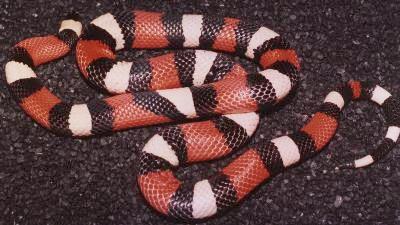
- Pueblan Milk Snake
- Lampropeltis triangulum campbelli
- Size:
- Hatchling: 7 - 8 in.
- Adult: 30 - 36 in.(normal)
- Scalation:
- Dorsal: 21 - 23 rows
- Ventral: 196 - 220
- Sub caudal: 40 - 49
- Infra labial: 7 - 9
- Supra labial: 7 - 8
- Anal Plate: Single
|

Photo Courtesy High Mountain Reptiles
click to enlarge |
Written by John Cherry
Coloration
Head:
Normally displays a light indistinct u on the frontal scale. Balance of head is black with the first band encroaching on the head and occasionally covering the nearly the entire head. (sockheads)
Dorsal:
A number of very variable color morphs are known such as typical tri-colored animals, apricot and tangerine phase animals. The red/orange bands and the white/apricot/tangerine bands are approximately twice as wide as the black bands on majority of body. Many specimens tend toward melanism with scales showing varying amounts of black tipping. This is more apparent in the white/yellow bands.
Ventral:
Black and white/yellow bands extend onto belly area with about half of the red bands being present.
Range:
Portions of Puebla, Morelos and Oaxaca, Mexico.
Habitat:
Very at home in arid portions of this range and found at elevations exceeding 5500 ft.
Prey:
In captivity these animals fair very well on a diet of lab. raised mice. Juveniles are large robust
neonates. They are generally aggressive feeders that are easy to start. In the wild they feed on small
lizards, small snakes, nestling birds with the bulk of the diet being rodents.
Behavior:
This is a large subspecies that does well in captivity. Wild caught individuals can be
prone to biting and are somewhat nervous. Captive born animals start out flighty as hatchlings, but with handling and age they tend to get away from this behavior. They become favorites in most collections, because of the beautiful color and their ease of care and breeding.
Breeding:
Breeding in captivity is achieved in the same manner as with most colubrids, with the exception that
this subspecies is known to double, and sometimes triple clutch. Clutch sizes vary but normally are between 6 and 8 eggs.
Use the following as a guideline. Towards the middle of October cease feeding totally, allowing at least 2 -3 weeks at normal temperature for clearing of the gut. Then gradually reduce the ambient tempeture inside the cage to the middle 50's/low 60's and maintain for a period of 3 months. Be sure and provide clean water and systematically check animals for general condition and welfare during this period. middle of the brumation cycle with good success. After brumation and the animals are brought back up to optimum temperature of 76 - 82 degrees, feeding should resume for approx. three weeks and the pair should be placed together under supervision for short periods of time until copulation can be confirmed. An egg laying chamber/box partially filled with damp vermiculite or sphagnum moss is helpful. Eggs should be removed immediately after laying and placed in damp vermiculite for the incubation period of 58 - 66 days at temperatures of 80 - 83 degrees.
Literature Cited:
Stebbins,Robert C. 1985 second editition revised. A field guide to Western
Reptiles and Amphibians. Houghton Mifflin Company
Cherry, John & Cindy Field & Breeding Notes
|
|
Sponsored Link
New & Updated Business Listings
Looking for a reptile or amphibian related business? A reptile store, breeder, importer,
maunfacturer or supplier? Our business directory lists some of the most popluar herp businesses in the world.
| Locate a reptile or amphibian business by name:
|
|
Recent Milk Snake Forum Forum Posts
• I'm here, too!, posted by Sunherp
• Kingsnake lives!, posted by exposito
• Hey Everybody, I'm here., posted by AaronBayer
• Scott Ballard Provided A Wealth Of Info, posted by Ameron
• Central America Milksnake Dilemma, posted by Ameron
• Retun to Forum / New Stuart's Milksnake , posted by Ameron
• Eggs ok?, posted by highley1980
• Splotched Sinaloan Variety, posted by bslugger551
• Splotched/Bullseye Sinaloans, posted by bslugger551
• Is my milk snake is getting TOO HOT?, posted by darbellah
• New owner looking for advice, posted by Irishfran
• New adoption biting and chewing fingers, posted by ajcur17
• Help*** Our milksnake won’t eat., posted by KieranSnake
• "trouble" with my milk snake, posted by kedjkd
• L. annulata (Mexican Milk) temps, posted by JJJ
Recent Milk Snake Classifieds:
- WANTED Milksnakesall spe...
- 4 foot Sinaloan Milksnak...
- 10 Adult Pueblan milk
Banner Pool
|







